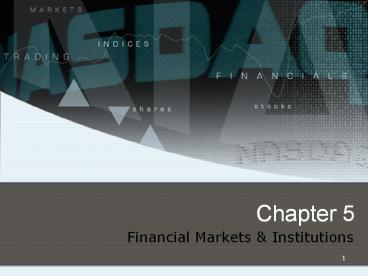Financial Markets - PowerPoint PPT Presentation
1 / 17
Title:
Financial Markets
Description:
U.S. Stock Markets. New York Stock Exchange(NYSE) American Stock Exchange (AMEX) ... New York and American Bond Exchanges. 13. Efficient Market Hypothesis (EMH) ... – PowerPoint PPT presentation
Number of Views:137
Avg rating:3.0/5.0
Title: Financial Markets
1
Chapter 5
- Financial Markets Institutions
2
Topics
- The Capital Allocation Process
- Financial markets
- Financial institutions
- Stock Markets and Returns
- Stock Market Efficiency
3
The Capital Allocation Process
- In a well-functioning economy, capital flows
efficiently from those who supply capital to
those who demand it. - Suppliers of capital individuals and
institutions with excess funds. These groups
are saving money and looking for a rate of return
on their investment. - Demanders or users of capital individuals and
institutions who need to raise funds to finance
their investment opportunities. These groups are
willing to pay a rate of return on the capital
they borrow.
4
How is capital transferred between savers and
borrowers?
- Direct transfers
- Investment banking house
- Financial intermediaries
5
Direct Transfer from saver-to-borrower
Funds
Savers
Savers
Borrowers
Borrowers
Claims
6
Indirect Transfer through Investment Banking House
Funds
Funds
Investment Banks
Primary
Primary
Claims
Claims
Borrowers
Savers
Primary
Primary
Claims
Claims
7
Indirect Transfer through Financial
Intermediary(FI)
Funds
Funds
Financial Inter- mediary Banks
Thrifts Mutual Fund Co.s Pension Funds Insurance
Co.s Finance Co.s
Primary
Claims
Borrowers
Savers
Primary /or
Secondary Claims
8
What is a market?
- A market is a venue where goods and services are
exchanged. - A financial market is a place where individuals
and organizations wanting to borrow funds are
brought together with those having a surplus of
funds.
9
Different Financial Market Classifications
- Money vs. Capital
- Short-term (money) financial securities vs.
Long-term financial securities - Spot vs. Future
- Private vs. Public
- Primary vs. Secondary
- The market for new financing vs. already issued
securities.
10
Derivative Markets and Securities
- A derivative securitys value is derived from
the price of another security (e.g., options and
futures). - Can be used to hedge or reduce risk. For
example, an importer, whose profit falls when the
dollar loses value, could purchase currency
futures that do well when the dollar weakens. - Also, speculators can use derivatives to bet on
the direction of future stock prices, interest
rates, exchange rates, and commodity prices. In
many cases, these transactions produce high
returns if you guess right, but large losses if
you guess wrong. Here, derivatives can increase
risk.
11
Different Financial Institutions
- Commercial Banks, Savings Loans, Credit Unions
- generally lend money to individuals and
businesses (assets), find deposits to fund these
loans (liabilities) - Insurance Companies sell policies and invest
premium proceeds - Pension Funds (tax sheltered)
- Defined Benefit vs. Defined Contribution
- Mutual Funds provide investment diversification
- Load vs. No-load
- Open-ended vs. Closed-ended
12
Some Specific Financial Markets
- U.S. Stock Markets
- New York Stock Exchange(NYSE)
- American Stock Exchange (AMEX)
- Brokered trading system with specialists/market
makers - Over-the-counter marketNASDAQ
- Dealer system with Bid and Ask prices
- International Stock Markets
- U.S. Bond Markets
- Mostly over the counter (Treasuries)
- New York and American Bond Exchanges
13
Efficient Market Hypothesis (EMH)
- Securities are normally in equilibrium and are
fairly priced. - Investors cannot beat the market except through
good luck or better information. - Levels of market efficiency
- Weak-form efficiency
- Semistrong-form efficiency
- Strong-form efficiency
14
Weak-form efficiency
- Cant profit by looking at past trends. A recent
decline is no reason to think stocks will go up
(or down) in the future. - Evidence supports weak-form EMH, but technical
analysis is still used.
15
Semistrong-form efficiency
- All publicly available information is reflected
in stock prices, so it doesnt pay to over
analyze annual reports looking for undervalued
stocks. - Largely true, but superior analysts can still
profit by finding and using new information.
16
Strong-form efficiency
- All information, even inside information, is
embedded in stock prices. - Not true--insiders can gain by trading on the
basis of insider information, but thats illegal.
17
Conclusions about market efficiency
- Empirical studies suggest the stock market is
- Highly efficient in the weak form.
- Reasonably efficient in the semistrong form.
- Not efficient in the strong form. Insiders have
made abnormal (and sometimes illegal) profits. - Behavioral finance
- Incorporates elements of cognitive psychology to
better understand how individuals and markets
respond to different situations.

